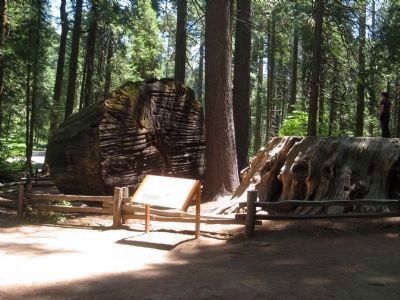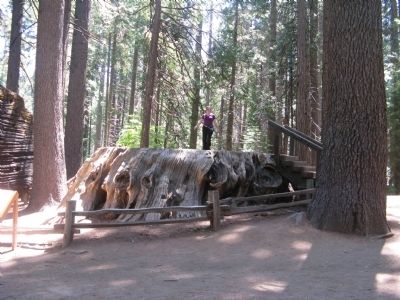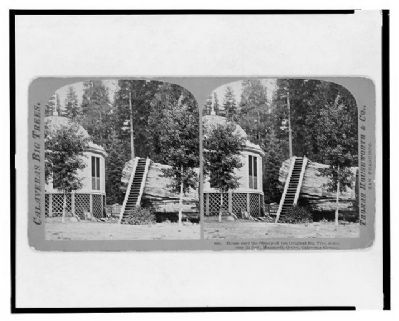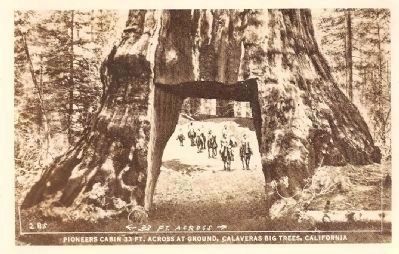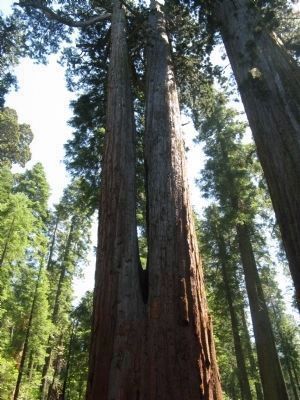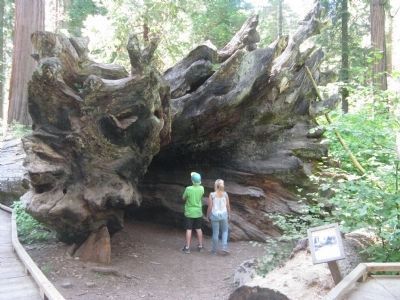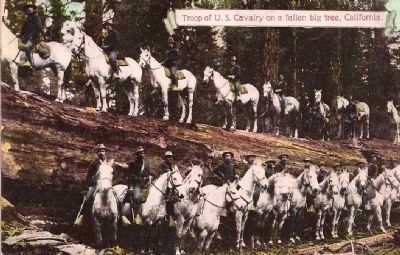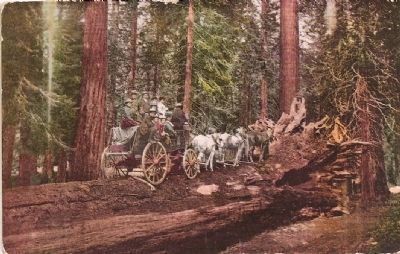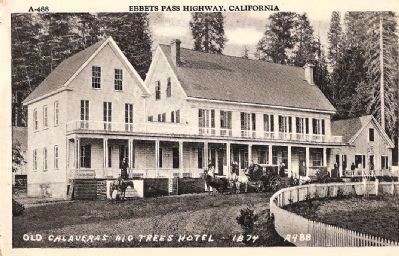Arnold in Calaveras County, California — The American West (Pacific Coastal)
California Big Trees State Park
The Discovery Stump
— The Calaveras North Grove —
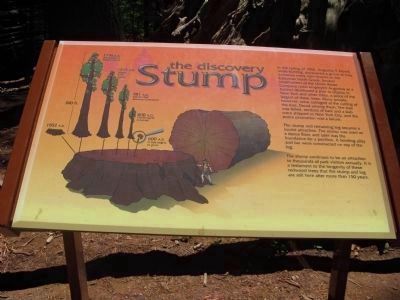
Photographed By Syd Whittle, August 7, 2010
1. The Discovery Stump Marker
Time line of tree growth - From right to left:
600 A.D. - A tree begins to grow
800 A.D. - Charlemagne crowned
982 A.D. - Erik the Red discovers Greenland
1215 A.D. - Magna Carte signed
1776 A.D. - Declaration of Independence - The tree now stands 300 feet tall.
1852 A.D. - The tree is cut down.
600 A.D. - A tree begins to grow
800 A.D. - Charlemagne crowned
982 A.D. - Erik the Red discovers Greenland
1215 A.D. - Magna Carte signed
1776 A.D. - Declaration of Independence - The tree now stands 300 feet tall.
1852 A.D. - The tree is cut down.
The stump and remaining log became a tourist attraction. The stump was used as a dance floor, and later was the foundation for a pavilion. A bowling alley and bar were constructed on top of the log.
The stump continues to be an attraction to thousands of park visitors annually. It is a testament to the longevity of these redwood trees that the stump and log are still here after more than 150 years.
Erected by California State Parks.
Topics and series. This historical marker is listed in this topic list: Horticulture & Forestry. In addition, it is included in the Historic Trees series list. A significant historical year for this entry is 1852.
Location. 38° 16.651′ N, 120° 18.503′ W. Marker is in Arnold, California, in Calaveras County. Marker can be reached from Big Trees Parkway near Ebbetts Pass Scenic Byway (California Highway 4). Marker and stump are located on the Calaveras North Grove Trail. Park at the Visitor Center and get a North Grove Trail Brochure. This is a fee-use state park. Touch for map. Marker is at or near this postal address: 1170 East Highway 4, Arnold CA 95223, United States of America. Touch for directions.
Other nearby markers. At least 8 other markers are within 6 miles of this marker, measured as the crow flies. Discovery and Exploitation (about 500 feet away, measured in a direct line); Hanging On By A Branch (approx. 0.3 miles away); White Pines History (approx. 1.9 miles away); Doc S.C. Linebaugh Park (approx. 2 miles away); Dorrington Hotel (approx. 2.3 miles away); Board's Crossing (approx. 4.4 miles away); Sourgrass Bridge (approx. 5.8 miles away); Avery Hotel (approx. 6 miles away). Touch for a list and map of all markers in Arnold.
Regarding California Big Trees State Park. There are 27 stops on the gentle 1.5 mile long Calaveras North Grove Trail of which The Discovery Stump is the first. Each stop points out specific Sequoias, additional tree species found in this forest, plants and animals, and the history of the area. John Muir once stated “They were the first discovered and are the best known. Thousands of travelers from every country have come to pay them tribute of admiration and praise.”
Also see . . .
1. Calaveras Big Trees State Park. Calaveras became a State Park in 1931 to preserve the North Grove of giant sequoias. This grove includes the "Discovery Tree", the first Sierra redwood noted by Augustus T. Dowd in 1852. This area has been a major tourist attraction ever since, and is considered the longest continuously operated tourist facility in California. (Submitted on August 6, 2010.)
2. How Big are Big Trees?. The largest redwood in Calaveras Big Trees State Park is the Louis Agassiz tree. It is located in the South Grove. This tree is "only" 250 feet tall, but it is over 25 feet in diameter six feet above the ground! The largest tree in the North Grove is probably the Empire State Tree, which is 18 feet in diameter six feet above the ground. The largest tree in the world is the General Grant tree, located in Sequoia-Kings Canyon National Park It stands 271 feet tall and is 28 feet in diameter at six feet above the ground. (Submitted on August 6, 2010.)
Additional commentary.
1. The Big Stump
From the Calaveras North Grove Trail Brochure:
In the spring of 1852, a backwoods hunter named Augustus T. Dowd was chasing a wounded grizzly bear in an unfamiliar forest. Suddenly he was stopped in his tracks by an unbelievable sight - a tree of monstrous proportions that was easily three times larger than any he had ever seen. Dowd spent the rest of the day exploring the area before returning to his campsite in the hills above Murphy's gold mining camp. Dowd was a colorful character, and his story of the big tree was initially met with skepticism. He finally coaxed a group of men to make the 20-mile trip into the mountains to see the tree for themselves.
Almost immediately, visitors began traveling up the rough trail to what became known as the Calaveras Grove. Word of the "Giant Trees" soon spread throughout the world.
In 1853, the year after Dowd's discovery, the tree was stripped of its bark and felled by ambitious speculators. Since no saw was large enough, the tree was felled with other tools of that era - long-handled pump augers and wedges. It took five men 22 days to drill all the holes, but the perfectly symmetrical tree did not fall for several days.
The stump was planed smooth to serve as a dance floor, and a two-lane bowling alley and bar were built on the fallen trunk.
Many were angered by the destruction of this tree, including Dowd. John Muir was so angered by this event that he wrote:
"The vandals then danced upon the stump!"
— Submitted August 6, 2010.

Photographed By Syd Whittle, August 7, 2010
4. The Discovery Stump and Log
This tree, eventually named "The Discovery Tree" was the largest tree in the North Grove. It was over 25 feet in diameter at the base and over 280 feet tall. When the rings were counted, it was found to be only 1,244 years old - relatively young for such a large Sequoia. Its most recent annual growth rings were large, indicating that it was growing very quickly. It is believed that if this tree had been allowed to live, it might rival the largest of the Giant Sequoias
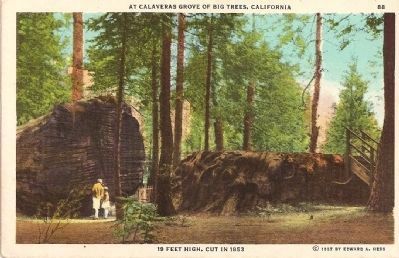
Photographed By Edward A. Hess, circa 1937
5. The Discovery Stump and Log - 19 Feet High, Cut in 1853
Description on postcard:
In 1853 five men worked 15 days to cut this tree just to see it fall. While they had gone to Averys to get whiskey to celebrate, the tree fell.
Being impossible to get a saw long enough for this job, they had to bore 3 inch holes from outside to center. Auger marks show in the picture.
In 1853 five men worked 15 days to cut this tree just to see it fall. While they had gone to Averys to get whiskey to celebrate, the tree fell.
Being impossible to get a saw long enough for this job, they had to bore 3 inch holes from outside to center. Auger marks show in the picture.
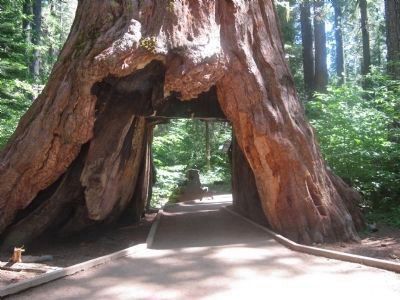
Photographed By Syd Whittle, August 7, 2010
7. The Pioneer Cabin Tree
This tree is Stop No. 21 on the Calaveras North Grove Trail:
As the roads to Yosemite improved, Yosemite Valley and its nearby Sequoia groves began to attract more and more visitors. Because of this competition, when the Wawona Tunnel Tree in Yosemite was carved out in the 1880's, the owners of the North Grove responded by doing the same to this tree.
As the roads to Yosemite improved, Yosemite Valley and its nearby Sequoia groves began to attract more and more visitors. Because of this competition, when the Wawona Tunnel Tree in Yosemite was carved out in the 1880's, the owners of the North Grove responded by doing the same to this tree.
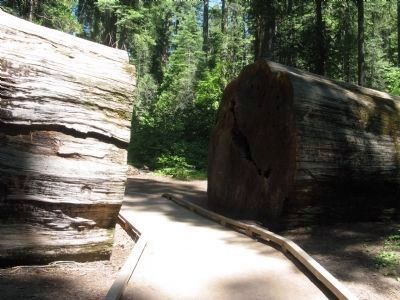
Photographed By Syd Whittle, August 7, 2010
10. Hercules
This tree is Stop No.12 on the Calaveras North Grove Trail:
This tree was one of the largest in the grove. It was blown down during a violent windstorm in December, 1861.
John M. Wooster was one of the early explorers to visit the grove in 1850. It was two years before Dowd's discovery. He claimed to have carved his name on this tree before it fell, but the evidence is now gone.
This tree was one of the largest in the grove. It was blown down during a violent windstorm in December, 1861.
John M. Wooster was one of the early explorers to visit the grove in 1850. It was two years before Dowd's discovery. He claimed to have carved his name on this tree before it fell, but the evidence is now gone.

Photographed By Syd Whittle, August 7, 2010
11. Father of the Forest
This tree is stop No. 13 on the Calaveras North Grove Trail:
This tree fell long before Euro-Americans discovered the grove. It has always been a favorite setting for photographers. Early photos show a brass band and a troop pf calvary posed on top of the trunk.
This tree fell long before Euro-Americans discovered the grove. It has always been a favorite setting for photographers. Early photos show a brass band and a troop pf calvary posed on top of the trunk.
Credits. This page was last revised on June 16, 2016. It was originally submitted on August 6, 2010, by Syd Whittle of Mesa, Arizona. This page has been viewed 5,852 times since then and 127 times this year. Photos: 1, 2, 3, 4. submitted on August 6, 2010, by Syd Whittle of Mesa, Arizona. 5. submitted on August 10, 2010, by Syd Whittle of Mesa, Arizona. 6. submitted on August 31, 2010, by Syd Whittle of Mesa, Arizona. 7. submitted on August 9, 2010, by Syd Whittle of Mesa, Arizona. 8. submitted on August 10, 2010, by Syd Whittle of Mesa, Arizona. 9, 10, 11, 12. submitted on August 9, 2010, by Syd Whittle of Mesa, Arizona. 13. submitted on August 10, 2010, by Syd Whittle of Mesa, Arizona. 14. submitted on August 9, 2010, by Syd Whittle of Mesa, Arizona. 15. submitted on August 10, 2010, by Syd Whittle of Mesa, Arizona.
